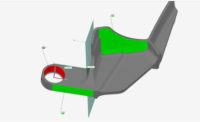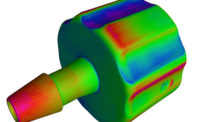
Laser scanning made it possible to preserve an aerospace legacy. Source: Creaform

The Glastar was scanned with Creaform’s REVscan self-positioning handheld laser scanner. Models were then made in CATIA V5 in order to reconstruct the surfaces and the molds. Source: Creaform
Nowadays, numerous aircraft companies are emerging and bank on the fact that this market segment is not yet fully occupied. These entrepreneurs buy the rights to manufacture discontinued aircraft, and, from scratch, take on the challenge of reviving the spirit of these older birds.
The task at hand is not a simple one, as these aircraft were never designed in 3-D computer-aided design (CAD)-this technology did not even exist at the time-and 2-D drawings are often out of date. What remains to be done is the painstaking measurement of everything on the aircraft and amendment of the drawings, if even available. However, 3-D scanning can simplify this process.
Reverse Engineering
Symphony Aircraft (Trois-Rivières, Quebec, Canada) saw the commercial appeal of reissuing the Stoddard-Hamilton Glastar. Symphony had bought the rights to manufacture it under its name, but could not rely on the 2-D drawings it had acquired. At the time, these drawings had not been updated with the modifications made to the manufacturer’s 3-D parts.
It was decided to use laser scanning and CAD surfacing technologies in order to build the panels, wings and other air-washed surfaces in a fast, cost-effective and simple way. Because Creaform (Lévis, Quebec, Canada) had already been involved in the 3-D laser scan of a small four-seater derived from a German design, the company was enlisted for Symphony’s reverse engineering needs.
The project spanned more than five weeks. First, surfaces were scanned with Creaform’s REVscan self-positioning handheld laser scanner. The parts were prepared-removed from the aircraft structure, if assembled, laid on a flat surface and fixtured-and then scanned in one shot, because the HandyScan has no volume limit, as opposed to an arm-mounted point-to-point scanner.
The scan data was then forwarded to the CAD department, where the 3-D models were reconstructed using the 1:1 scale scan data. At this point, any surface irregularities coming from the real parts were corrected to make ‘perfect’ nominal parts. From these models, shrink factors were applied to design the molds, thus adding flanges, molding analysis and scribe/trim lines for production.
A Legacy Preserved
Laser scanning has proved to be an efficient tool in the completion of extensive and complex projects such as this one. “At the project onset, we only had 2-D drawings of the aircraft parts to produce,” says Mirko Zgela, director at Symphony. “We did not know how accurate and up-to-date these were. Thanks to the reverse engineering that was done on real parts by Creaform, we could start cutting tools and molds, secured in the knowledge that they would produce good parts the first time.” This technology makes it possible to preserve the aerospace legacy that has been left throughout the years and pass it on to generations to come.
Benefits
- Originally, Symphony had only 2-D drawings to work with; laser scanning allowed the measurement and reproduction of parts exactly to specification.- It is estimated that Symphony saved tens of thousands of dollars by electing to use laser scanning technology rather than point-to-point.
- Because Creaform scanned real parts, Symphony could start cutting tools and molds, secure in the knowledge that they would produce good parts the first time.
Creaform
(418) 833-4446
www.creaform3d.com
Reply 16

